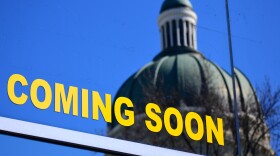Indiana Lt. Gov. Micah Beckwith, who is is six months into a convention-arranged political marriage with Indiana Gov. Mike Braun, is complying with certain executive orders because he wants to — not because he has to.
The interpretation comes after Beckwith’s Statehouse executive office has been repeatedly closed to the public during business hours in recent weeks, even though Braun directed state agencies to return full-time employees to in-person work by July 1.
Both offices agree that agencies Beckwith oversees — the Indiana State Department of Agriculture and the Office of Community and Rural Affairs — are bound by the order.
But the lieutenant governor himself is among just six separately selected statewide officeholders detailed in Indiana’s constitution. Beckwith is the second in command in the executive branch but also presides over the Indiana Senate.
This means that some employees under the lieutenant governor’s authority could have to follow executive orders while others wouldn’t.
Beckwith Spokesman James Kehoe maintains that Beckwith’s office has chosen to follow the in-office order, including his executive and business teams.
Beckwith “believes in the spirit” of the order, so the office is “voluntarily complying,” Kehoe wrote. He cited two Statehouse attorneys who “both gave us the legal opinion” that the office “isn’t bound by” the directive.
Braun’s office indicated separately elected and nominated officials can opt into certain executive orders.
“We are setting a policy and we are leading,” Braun’s General Counsel Patrick Price said. “And you know, if other state elected officials want to follow the governor’s lead, we … welcome them to do that.”

The running mates began their new roles in January. Their partnership has included disagreements over policy and public remarks.
Republican delegates narrowly selected Beckwith as the GOP nominee for lieutenant governor in a surprising vote at a party convention last June, rebuffing Braun’s handpicked choice for the role.
‘Potential’ for split goes back decades
Representatives for the two leaders had slightly differing explanations for whether executive orders do or don’t apply.
Braun’s office pointed to a chapter of Indiana Code about the state’s civil service system, which specifically exempts the governor, lieutenant governor and four other statewide elected officials from such personnel requirements.
“If you’re separately elected or separately nominated, your accountability is to the voters, not the governor,” Price said.
Budget-related orders would still apply to everyone, however.
Beckwith’s office indicated it uses a case-by-case approach.
“Since all Executive Orders are different, you’d need to ask about each specifically for me to address this,” Kehoe said.
He confirmed the office has sought an opinion — essentially, legal advice — from the Office of Attorney General, “but we have not heard back.”
Indiana’s governor and lieutenant governor have run on the same ticket since the 1976 elections, when a constitutional amendment went into effect.
Until then, the two were separately elected. Voters approved the change in a 56%-44% referendum two years prior.
Proponents argued the amendment would boost cooperation between the state’s two top officeholders because they’d at least belong to the same party, according to a 1974 edition of the Nappanee Advance-News.
Opponents held that the dual ticket would limit voter options and reduce the lieutenant governor to a “rubber stamp” of the governor’s perspective.
Paul Helmke, a professor at Indiana University Bloomington’s School of Public and Environmental Affairs, said it’s likely the first time “we’ve had that kind of conflict” since the amendment took effect.
Helmke served three terms as the Republican mayor of Fort Wayne, leaving office in 2000. He led the Brady Campaign to Prevent Gun Violence for five years and joined IU’s faculty in 2013.
“They’ve always been a team,” he said of the two roles. “But this one, I mean, we knew was going to be different, just going back to the convention.”
Party insiders pick the lieutenant governor nominee in at springtime conventions. They typically — but don’t always — fall in line with the preference of the gubernatorial nominee, who is chosen by primary election voters.
That difference in selection mechanisms is why “there’s always been a potential for a split between the two,” Helmke said.
Indiana Capital Chronicle is part of States Newsroom, a nonprofit news network supported by grants and a coalition of donors as a 501c(3) public charity. Indiana Capital Chronicle maintains editorial independence. Contact Editor Niki Kelly for questions: info@indianacapitalchronicle.com.




